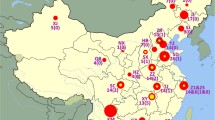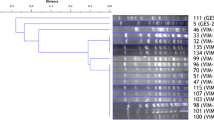Abstract
Pseudomonas aeruginosa is an important opportunistic pathogen responsible for nosocomial infections and is currently reported to be a worldwide nosocomial menace. The aim of this study was to investigate the epidemiological traits and the distribution of metallo-β-lactamases (MBLs)-producing P. aeruginosa clinical isolates in ten cities in China between January 2010 and May 2012. Antimicrobial susceptibility was determined by disc diffusion assay and the minimum inhibitory concentrations (MICs) of imipenem and meropenem were also determined by the Etest according to Clinical and Laboratory Standards Institute (CLSI) guidelines. In addition, polymerase chain reaction (PCR) and DNA sequencing were applied to detect bla MBL genes, and their epidemiological relationships were investigated by multilocus sequence typing (MLST). Of 368 P. aeruginosa isolates, MLST analysis identified 138 sequence types (STs), including 122 known and 16 novel STs, and the most frequently detected clone was ST244, followed by ST235. Besides, our study revealed that 25 isolates carried the bla IMP-6 gene and three isolates carried the bla VIM-2 gene, and a probe specific for both genes could be hybridised to an ~1,125-kb fragment in all isolates. Interestingly, all of the bla IMP-6-producing isolates shared an identical ST, ST244, and exhibited a higher level of resistance to several antibiotics. Overall, these observations suggest that P. aeruginosa ST244 carrying the chromosomally located bla IMP-6 gene is widely disseminated in multiple cites in China.

Similar content being viewed by others
References
Wolter DJ, Lister PD (2013) Mechanisms of beta-lactam resistance among Pseudomonas aeruginosa. Curr Pharm Des 19(2):209–222
Queenan AM, Bush K (2007) Carbapenemases: the versatile beta-lactamases. Clin Microbiol Rev 20(3):440–458
Edelstein MV, Skleenova EN, Shevchenko OV, D’Souza JW, Tapalski DV, Azizov IS, Sukhorukova MV, Pavlukov RA, Kozlov RS, Toleman MA, Walsh TR (2013) Spread of extensively resistant VIM-2-positive ST235 Pseudomonas aeruginosa in Belarus, Kazakhstan, and Russia: a longitudinal epidemiological and clinical study. Lancet Infect Dis 13(10):867–876
Edalucci E, Spinelli R, Dolzani L, Riccio ML, Dubois V, Tonin EA, Rossolini GM, Lagatolla C (2008) Acquisition of different carbapenem resistance mechanisms by an epidemic clonal lineage of Pseudomonas aeruginosa. Clin Microbiol Infect 14(1):88–90
Hammami S, Gautier V, Ghozzi R, Da Costa A, Ben-Redjeb S, Arlet G (2010) Diversity in VIM-2-encoding class 1 integrons and occasional bla(SHV2a) carriage in isolates of a persistent, multidrug-resistant Pseudomonas aeruginosa clone from Tunis. Clin Microbiol Infect 16(2):189–193
Szabó D, Szentandrássy J, Juhász Z, Katona K, Nagy K, Rókusz L (2008) Imported PER-1 producing Pseudomonas aeruginosa, PER-1 producing Acinetobacter baumanii and VIM-2-producing Pseudomonas aeruginosa strains in Hungary. Ann Clin Microbiol Antimicrob 7:12
Viedma E, Juan C, Villa J, Barrado L, Orellana MA, Sanz F, Otero JR, Oliver A, Chaves F (2012) VIM-2-producing multidrug-resistant Pseudomonas aeruginosa ST175 clone, Spain. Emerg Infect Dis 18(8):1235–1241
Spilker T, Coenye T, Vandamme P, LiPuma JJ (2004) PCR-based assay for differentiation of Pseudomonas aeruginosa from other Pseudomonas species recovered from cystic fibrosis patients. J Clin Microbiol 42(5):2074–2079
Clinical and Laboratory Standards Institute (CLSI) (2012) Performance standards for antimicrobial susceptibility testing; Twenty-second informational supplement. CLSI document M100-S22. CLSI, Wayne, PA
Ellington MJ, Kistler J, Livermore DM, Woodford N (2007) Multiplex PCR for rapid detection of genes encoding acquired metallo-beta-lactamases. J Antimicrob Chemother 59(2):321–322
Lee K, Lim YS, Yong D, Yum JH, Chong Y (2003) Evaluation of the Hodge test and the imipenem-EDTA double-disk synergy test for differentiating metallo-beta-lactamase-producing isolates of Pseudomonas spp. and Acinetobacter spp. J Clin Microbiol 41(10):4623–4629
Curran B, Jonas D, Grundmann H, Pitt T, Dowson CG (2004) Development of a multilocus sequence typing scheme for the opportunistic pathogen Pseudomonas aeruginosa. J Clin Microbiol 42(12):5644–5649
Larkin MA, Blackshields G, Brown NP, Chenna R, McGettigan PA, McWilliam H, Valentin F, Wallace IM, Wilm A, Lopez R, Thompson JD, Gibson TJ, Higgins DG (2007) Clustal W and Clustal X version 2.0. Bioinformatics 23(21):2947–2948
Jolley KA, Feil EJ, Chan MS, Maiden MCJ (2001) Sequence type analysis and recombinational tests (START). Bioinformatics 17(12):1230–1231
Héritier C, Poirel L, Aubert D, Nordmann P (2003) Genetic and functional analysis of the chromosome-encoded carbapenem-hydrolyzing oxacillinase OXA-40 of Acinetobacter baumannii. Antimicrob Agents Chemother 47(1):268–273
Walsh TR, Toleman MA, Poirel L, Nordmann P (2005) Metallo-beta-lactamases: the quiet before the storm? Clin Microbiol Rev 18(2):306–325
Yano H, Kuga A, Okamoto R, Kitasato H, Kobayashi T, Inoue M (2001) Plasmid-encoded metallo-beta-lactamase (IMP-6) conferring resistance to carbapenems, especially meropenem. Antimicrob Agents Chemother 45(5):1343–1348
Jeong JH, Shin KS, Lee JW, Park EJ, Son S-Y (2009) Analysis of a novel class 1 integron containing metallo-beta-lactamase gene VIM-2 in Pseudomonas aeruginosa. J Microbiol 47(6):753–759
Samuelsen O, Toleman MA, Sundsfjord A, Rydberg J, Leegaard TM, Walder M, Lia A, Ranheim TE, Rajendra Y, Hermansen NO, Walsh TR, Giske CG (2010) Molecular epidemiology of metallo-beta-lactamase-producing Pseudomonas aeruginosa Isolates from Norway and Sweden shows import of international clones and local clonal expansion. Antimicrob Agents Chemother 54(1):346–352
Valenza G, Joseph B, Elias J, Claus H, Oesterlein A, Engelhardt K, Turnwald D, Frosch M, Abele-Horn M, Schoen C (2010) First survey of metallo-beta-lactamases in clinical isolates of Pseudomonas aeruginosa in a German university hospital. Antimicrob Agents Chemother 54(8):3493–3497
Lee K, Park AJ, Kim MY, Lee HJ, Cho J-H, Kang JO, Yong D, Chong Y; KONSAR group (2009) Metallo-beta-lactamase-producing Pseudomonas spp. in Korea: high prevalence of isolates with VIM-2 type and emergence of isolates with IMP-1 type. Yonsei Med J 50(3):335–339
Tada T, Miyoshi-Akiyama T, Shimada K, Shimojima M, Kirikae T (2013) IMP-43 and IMP-44 metallo-beta-lactamases with increased carbapenemase activities in multidrug-resistant Pseudomonas aeruginosa. Antimicrob Agents Chemother 57(9):4427–4432
Livermore DM (2002) Multiple mechanisms of antimicrobial resistance in Pseudomonas aeruginosa: our worst nightmare? Clin Infect Dis 34(5):634–640
Kidd TJ, Ritchie SR, Ramsay KA, Grimwood K, Bell SC, Rainey PB (2012) Pseudomonas aeruginosa exhibits frequent recombination, but only a limited association between genotype and ecological setting. PLoS One 7(9):e44199
Empel J, Filczak K, Mrówka A, Hryniewicz W, Livermore DM, Gniadkowski M (2007) Outbreak of Pseudomonas aeruginosa infections with PER-1 extended-spectrum beta-lactamase in Warsaw, Poland: further evidence for an international clonal complex. J Clin Microbiol 45(9):2829–2834
Maatallah M, Cheriaa J, Backhrouf A, Iversen A, Grundmann H, Thuy D, Lanotte P, Mastouri M, Elghmati MS, Rojo F, Mejdi S, Giske CG (2011) Population structure of Pseudomonas aeruginosa from five Mediterranean countries: evidence for frequent recombination and epidemic occurrence of CC235. PLoS One 6(10):e25617
Ryoo NH, Lee K, Lim J-B, Lee YH, Bae IK, Jeong SH (2009) Outbreak by meropenem-resistant Pseudomonas aeruginosa producing IMP-6 metallo-beta-lactamase in a Korean hospital. Diagn Microbiol Infect Dis 63(1):115–117
Funding
This work was supported by research grants from the Zhejiang Medical Science and Technology Plan [2013ZB059].
Conflict of interest
None declared.
Ethical approval
Not required.
Author information
Authors and Affiliations
Corresponding author
Rights and permissions
About this article
Cite this article
Chen, Y., Sun, M., Wang, M. et al. Dissemination of IMP-6-producing Pseudomonas aeruginosa ST244 in multiple cities in China. Eur J Clin Microbiol Infect Dis 33, 1181–1187 (2014). https://doi.org/10.1007/s10096-014-2063-5
Received:
Accepted:
Published:
Issue Date:
DOI: https://doi.org/10.1007/s10096-014-2063-5




